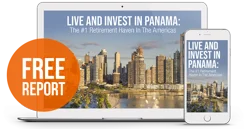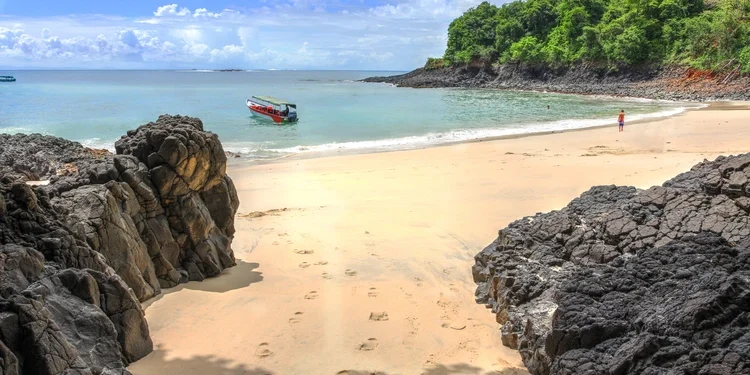“As a new arrival in Panama City, I had a lot to figure out… and I have to admit that, often, I felt overwhelmed…”
So began Sophia Titley when she took the stage to address all those convened in the meeting rooms of the Central Hotel in Casco Viejo for the final day of our 2018 Live and Invest in Panama Conference.
Sophia’s “Just Landed! Getting Set Up In Panama” presentation walked attendees at the event through all practical aspects of establishing yourself and launching a new life in this country.
“This talk is designed to arm you with everything you need to know to get settled in Panama and to make your transition to life here smoother than mine was!” Sophia explained.
“In your previous life, you may have taken a certain level of logic and efficiency for granted in your everyday interactions,” she continued.
“Now you’re in Panama. Things are different here.
“Some days you will want to bang your head against the wall, but all the idiosyncrasies of this country are also part of the fun. With the help of insights and experience I’m about to share, my hope is that you’ll be more and better prepared for life in this unique and exciting place.”
Sophia carried on to walk the group through all aspects of day-to-day living in Panama… and these haven’t changed a whole lot in the years since.
Getting Around
Up until this point in your life, you may not have considered sidewalks a luxury. Now that you’re in Panama, you’ll need to adjust that thinking.
If you’re trying to navigate Panama City on foot and are lucky enough to find an actual sidewalk, chances are it will be rocky, overgrown with tree roots, littered with garbage, or pitted with potholes that drop down into no-man’s-land.
When walking around Panama City, you need to take care with every step. Do not look up at the pretty high-rise buildings all around you. Keep your eyes focused down on the ground watching for impediments… lest you end up at the bottom of one of those giant potholes.
It used to be that, if you didn’t own your own car, the only option for getting around Panama City was a taxi.
Taxis in Panama are cheap compared with North American prices. The average fare is about $5. If you’re going to use a taxi, be sure you have cash and small notes. Cabbies conveniently never have change for your $10 or $20 bill.
That said, we’d recommend against using taxis in Panama City. Panama City taxi drivers are among the least cool people on the planet. These guys are disagreeable and often untrustworthy.
A better option today is to use Uber. Drivers working with these services are required to register, which adds a level of accountability.
“As a young single woman in Panama City, this is the service I feel most comfortable using,” pointed out Sophia.
In addition, today you have another option for getting around Panama City—ever improving public transportation.
Your first option for public transportation is the Metrobus. These have been operating on the streets of Panama City since 2012 and are familiar and safe. You’ll need a Metrocard to ride these buses. Swipe your card when you get on board and hit the red button when you want to exit. Metrocards are sold at all metro stops, grocery stores, and the Albrook bus terminal.
Your second public transportation option is the metro.
Panama is the first country in Central America to build a metro; the first line, which opened in 2014, runs from San Isidro station in the northeast of the city to Albrook Station (home of the famous mall and the city’s biggest bus terminal) toward the southwest.
Line 2 runs from San Miguelito to Tocumen International Airport.
Line 3, which will go over the Canal and connect to neighborhoods west of the city, is in the works and expected to begin operations in mid-2025.
Your most authentic option, though not recommended, for public transport is the Diablo Rojo. These are retired school buses from the United States that have been pimped out with colors, neon lights, decorations of all kinds, and serious sound systems… all of which are meant to serve as incentive for you to get on board.
Get Your Free Panama Report Today!
Simply enter your email address below and we'll send you our FREE REPORT - Live And Invest In Panama: The #1 Retirement Haven In The Americas.
Panama City’s Diablos Rojos are such a curiosity that the Urban Contemporary Art Museum in Amsterdam has bought some for their collection.
Interesting and colorful, yes… practical, no. These Red Devils roar, grind, and smoke their way down Panama’s streets. They are overcrowded, not air conditioned, crazy noisy, and unsafe. Plus, it’s usually really hard to figure out the route.
If and when you decide to invest in a car, the best places to look for a deal on a used vehicle are the local classifieds such as encuentra24. Take your time and watch for fire sales offered by foreigners leaving the country who need their cars sold quickly.
There’s no Kelley Blue Book or equivalent in Panama, so you’ll have to judge for yourself what a secondhand vehicle is worth. That said, you should always negotiate. This is expected.
Setting Up Utilities
To set up your utilities, you’ll need a permanent address here first, meaning you can’t start the process until you’ve rented or bought a place to live.
When you’ve done that, take your passport and address to the utility company.
You’ll be asked to fill out a form that asks rather odd questions— such as how often do you iron your clothes?… and, do you own a hairdryer?— in an effort to gauge how much electricity you will use each month and, therefore, how much you’ll need to pay as a deposit.
You’ll be given an appointment for installation within the next few days. Clear your schedule the day of the appointment because you won’t know what time the guys will be coming… they will give you a time but it’s highly unlikely that they’ll show up at that time.
Paying bills can be more complicated than you imagine.
The question is: How do you receive paper bills in a country that doesn’t use addresses or have a to-your-door mail-delivery system?
The answer is: Often you don’t.
The utility company might slip your bill into your front gate or leave it in a shrub outside your house. It might then fall on the ground or be carried off by a bird as fodder for his nest…
Regardless, it’s your responsibility to find your bill and to pay it. The one thing the utility companies here are really efficient at is shutting off your service if you’re payment is late.
I say forget about the paper bill. Opt for an e-bill, which is now possible!
Until next time,

Kathleen Peddicord
Founding Publisher, In Focus: Panama










